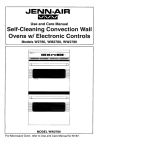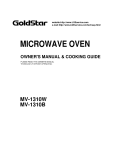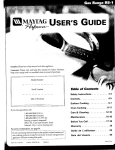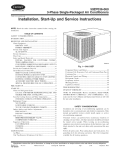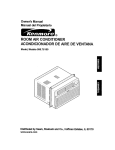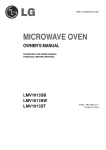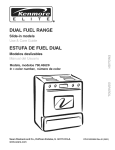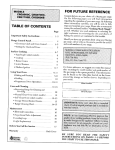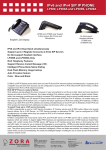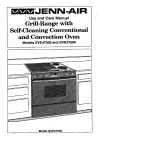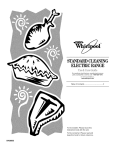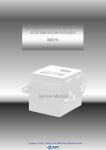Download Jenn-Air W131 Double Oven User Manual
Transcript
JENN.AIR Use and Care Manual Self-Cleaning Electronic Wall Oven Model W131 [BIBLE_;H[E[]_]J I_ 0 o 0 SAFETY PRECAUTIONS Read before operating your oven All appliances - regardless of the manufacturer - have the potential through improper or careless use to create safety problems. Therefore the following safety precautions should be observed: 1. 2. 3. 4. 5. 6. 7. 8. 9. 10. 11. 12. 13. 14. Be sure your appliance is properly installed and grounded by a qualified technician. Never use your appliance for warming or heating the room. Children should not be left alone or unattended in area where appliance is in use. They should never be allowed to sit or stand on any part of the appliance. Wear proper apparel. Loose-fitting or hanging garments should never be worn while using the appliance. Do not repair or replace any part of the appliance unless specifically recommended in this manual. All other servicing should be referred to an authorized Jenn-Air Service Contractor. Flammable materials should not be stored in an oven. Do not use water on grease fires. Smother fire or flame or use dry chemical or foam-type extinguisher. Use only dry potholders. Moist or damp potholders on hot surfaces may result in burns from steam. Do not let potholder touch hot heating elements. Do not use a towel or other bulky cloth. Use care when opening oven door. Let hot air or steam escape before removing or replacing food. Do not heat unopened food containers. Build-up of pressure may cause container to burst and result in injury. Keep oven vent ducts unobstructed. Always place oven racks in desired location while oven is cool. If rack must be moved while oven is hot, do not let potholder contact hot heating element in oven. Do not clean door gasket. The door gasket is essential for a good seal. Care should be taken not to rub, damage, or move the gasket. Do not use oven cleaners. No commercial oven cleaner or oven liner protective coating of any kind should be used in or around any part of the oven. 15. 16. 17. 18. 19. 20. Clean only parts listed in this manual. CAUTION: BEFORE SELF-CLEANING THE OVEN, REMOVE FOOD, BROILER PAN AND OTHER UTENSILS. Listen for fan. A fan noise should be heard during the broil and cleaning cycles. If not, call a serviceman before self-cleaning again. DO NOT TOUCH HEATING ELEMENTS OR INTERIOR SURFACES OF OVEN. Heating elements may be hot even though they are dark in color. Interior surfaces of any oven may become hot enough to cause burns. During and after use, do not touch, or let clothing or other flammable materials contact heating elements or interior surfaces of oven until they have had sufficient time to cool. Other surfaces of the appliance may become hot enough to cause burns-among these surfaces are: oven vent openings and surfaces near these openings, oven doors, windows of oven doors. Do not allow aluminum foil to contact heating element. PREPARED FOOD WARNING: Follow food manufacturer's instructions. If a plastic frozen food container and/or its film cover distorts, warps or is otherwise damaged during cooking, immediately discard the food and its container. The food could be contaminated. IMPORTANT SAFETY NOTICE AND WARNING The California Safe Drinking Water and Toxic Enforcement Act of 1986 (Proposition 65) requires the Governor of California to publish a list of substances known to the State of California to cause cancer or reproductive harm, and requires businesses to warn customers of potential exposures to such substances. Users of this appliance are hereby warned that when the oven is engaged in the self-clean cycle, there may be some low level exposure to some of the listed substances, including Carbon Monoxide. Exposure to these substances can be minimized by properly venting the oven to the outdoors during the self-clean cycle. Oven Operation Oven Control Panel The control panel is designed for ease in programming. Indicator Words which describe the functions set. The Display Window features To program: 1. Touch the function pad to give command desired. 2. Turn the Set Dial to enter time or temperature. NOTE: Three seconds after turning dial, time or temperature will automatically be entered. If more than 30 seconds elapse between touching a pad and turning set dial, control is not set and Display will return to previous Display ---Cancel=_- I SETCLEAN _ 9STOP 0IMER COOK T 8!_£ _ik::::::::_i_ i!iClean!i!_l_ Function Ime_l ©J Broil Il} '_"'P I Pads: [ BAKE TEMP I CLEAN I Use to set self-cleaning I BROIL IUsef°rt°pbr°wning°r°venbr°iling I ON I Use for baking or roasting. OFF CANCEL I process. Cancels all programming . except Timer and Clock. I TIME COOK I CLOCK I STOP TIME 1 minutes. Use to signal expiration of a time period up to 9 hours and 50 I TIMER I is Use desired. for clock controlled cooking and cleaning when delayed start 1 Use for clock controlled cooking. I Use to set time of day. 6 Set Dial: Use to set time, temperature, Display Window: or to select Hi or Lo Broil. Shows time of day, timer, and oven functions. Oven Light Switch (Control Panel - Center ): The oven light automatically comes on whenever the oven door is opened. When door is closed, push in oven light switch to turn oven light on or off. Display Numerals: • Show time of day. • Countdown of time remaining when using time functions. • Show temperature of oven as it rises to reach programmed temperature and the set temperature once it is reached. • Serve as a reminder to shut oven door, if it is open, for self-cleaning operation when the word, door, is displayed. • Recall programmed Indicator temperature or time when commanded. Words: • Flash to prompt next step. • Indicate status of programmed • Show programmed function. function when recalled. IMPORTANT DO NOT MOVE DOOR LOCK LEVER TO THE RIGHT DURING A COOKING OPERATION. If the door lock lever is moved to the lock position, the cooking operation will automatically be cancelled and "door" will appear in the display. Clock Controls When electrical power is supplied or after power interruption, the last clock time displayed before power was interrupted will flash. Time will advance and continue to flash until clock is reset. To set 1. time of day: Touch Clock Pad. Indicator words SET TIME will flash and time digits will appear in the Display. (If more than 30 seconds elapse between touching Clock Pad and turning the Set Dial, the Clock Pad must be touched again in order to set clock.) 2. Turn Set Dial in either direction until correct time of day appears in Display. NOTE: Three seconds after turning dial, time of day will automatically be entered. To recall time of clay when another time function is showing: Touch Clock Pad. (Note: To return to another time function pad, touch the appropriate pad.) To change time of day set on clock: Repeat above sequence. 3 ! NOTE: ClockTime Bake or Self-clean. cannot be changed when oven has been programmed forTimed Cancel program before reprogramming clock, ] i Timer IMPORTANT: This interval Timer can be used to remind you when a period, up to 9 hours and 55 minutes, expires. It can be used independently of any other oven activity and can be set while another oven function is operating. The Timer does not control the oven. To set Timer: 1. Touch Timer Pad. The Indicator Words Set Timer will flash and ":00" appears in the Display. 2. Turn Set Dial clockwise until desired number of minutes and seconds or hours and minutes appear in Display. NOTE: If more than 30 seconds elapse between touching Timer Pad and turning Set Dial, the Timer Pad must be touched again to set the numbers. IMPORTANT: This is the only function where time can be entered in minutes and seconds. When entering minutes and seconds, minutes are to the left of colon and seconds to right of colon. When entering hours and minutes, hours are to the left of the colon with the Hr Indicator word and minutes are to the right of colon.. EXAMPLE: Turn the dial to ":05" for 5 seconds, "5:00" for 5 minutes, or "5 Hr:00" for 5 hours and 0 minutes. 05 TI_ 5 seconds 5"00 TIMER 5 minutes 5 hours TIMEA and 0 minutes Countdownwillstartafter 3 seconds, At end of time set, the Timerwill beep 3 times. To cancel 1. 2. Timer: Hold in Timer Pad for 3 seconds. OR A. Touch Timer Pad B. Turn Set Dial counterclockwise until ":00" appears in Display Window. NOTE: Touching Cancel/Off Pad to cancel signal will cancel ALL selected oven programming. Oven Operation-Baking To set oven or Roasting on bake: 1. Place oven racks on proper rack positions. (See p.ll 2. Touch Bake Temp Pad. Indicator Word BAKE and "000 °" will appear in the Display. NOTE: If more than 30 seconds elapse between touching Bake Pad and turning the Set Dial, the oven is not set and Display will return to previous Display. 3. Turn Set Dial clockwise until desired oven temperature appears in the Display. (Allowable range is 170° to 550°.) After 3 seconds the oven will begin to preheat. The Indicator Words ON and BAKE will appear in the Display. The temperature shown will be 75 ° or the oven temperature whichever is higher. EXAMPLE: If at 10 o'clock you set the oven for 350 ° for baking, after 3 seconds the Display will show: I0-00 During the preheat, the Display will show a rise in 5° increments until programmed temperature is reached. When the oven is preheated, the oven will beep, the ON and BAKE Indicator Words and programmed oven temperature will remain in the display. NOTE: Oven will preheat for approximately 7 to 10 minutes. To recall temperature set during preheat: Touch the Bake Temp Pad. Temperature will be briefly displayed, then will automatically return to on-going program. To change temperature desired temperature. 4. Touch Cancel/Off set: Touch the Bake Temp Pad and turn Set Dial to new Pad to turn oven off at end of baking. 10 Rack Positions The rack positions noted are generally recommended for the bestbrowning results and most efficient cooking times. Refer to baking and roasting sections for recommendations for specific foods. Use Rack Position #1: Large cuts of meat and large poultry, angel food cake, frozen fruit pie, dessert souffle. Use Rack Position #2: Roasting small cuts of meat, cakes (tube, bundt or layer) custard pie, pie shell, large casseroles, loaves of bread. Use Rack Position #3 Most baked goods on cookie sheets, frozen convenience foods, fresh fruit pie, cream pie, layer cakes, main dish souffle. Use Rack Position #4: Most broiling. Multiple Rack Cooking: Two racks, use #2 and #4 or #1 and #4. 11 Clock Controlled Baking or Roasting BASIC INSTRUCTIONS 1. Touch Bake Temp Pad. 2. Turn Set Dial to desired temperature. 3. Touch Cook Time Pad. 4. Turn Set Dial to enter cooking hours & minutes. 5. Touch Stop Time Pad.* 6. Turn Set Dial to enter Stop Time.* *Omit steps 5 & 6 if you want baking to start immediately. To set oven to start immediately and shut off automatically: 1. Touch Bake Temp Pad Indicator Word BAKE and "000 °" will be shown in Display. 2. Turn Set Dial clockwise until desired oven temperature appears in the Display. After 3 seconds the oven will begin to preheat. The Indicator Words ON and BAKE will appear in the Display. The temperature shown will be 750 or the temperature of the oven, whichever is higher. EXAMPLE: If at 10 o'clock you set the oven for 3500 for baking, the Display will show: 3. 4. During the preheat, the Display will show a rise in 50 increments until programmed temperature is reached. When the oven is preheated, the oven will beep, the ON and BAKE Indicator Words and programmed oven temperature will remain in the display. Touch Cook Time Pad. Indicator Words SET COOK TIME will flash and Display will show "0 HR:00". Turn Set Dial to enter cooking hours in 5 minute increments. Hours are to left of colon and minutes to right of colon. (Allowable range is 10 minutes to 11 hours and 50 minutes.) EXAMPLE: If cooking time selected for the oven is 2 hours and 30 minutes, after 3 seconds the Display will show: and, the oven begins to preheat. 12 IMPORTANT: Oven will preheat for approximately 7 to 10 minutes. At end of programmed Cook Time, oven will shut off automatically; retained heat will continue to cook food. Clock controlled cooking is not recommended for baked items that require a preheated oven, such as cakes, cookies, pies, breads. For these foods, place food in preheated oven, then use Timer to signal end of baking time. At the end of programmed Cook Time, the oven will shut off automatically and continuous "beeps" will signal until the Cancel/Off Pad is touched. To set oven to start at future time and shut off automatically: 1. Follow preceding Steps 1-4. 5. Touch Stop Time Pad. Indicator Words SET STOP TIME will flash, Display will show the calculated stop time based on current time of day and cook time. 6. Turn Set Dial clockwise. A stop time can only be accepted for later in the day. NOTE: Since food continues to cook if left in the oven, it is suggested that the clock controls be used primarily to start the oven when no one is in the kitchen. Provisions should be made to have the food removed as soon as the signal has sounded. EXAMPLE: If at 10 o'clock you set the oven for 3500 for baking and 2 hours and 30 minutes cooking time, the calculated stop time would be "12:30". The Display would show: J12:30 SFf ST(_T_E _ _E If you want the stop time to be 1 o'clock, turn the Set Dial until "1:00" appears in the Display Window. Three seconds after turning dial, the Display Window will return to current time of day, thus showing: At the end of the delayed period, the DELAY Indicator Word will go off and the oven will begin to heat. 75 owill be shown. As the oven heats, the Display will show a rise in increments of 5° until programmed temperature is reached. At the end of programmed Cook Time, the oven will shut off automatically and continuous "beeps" will be heard. Touch Cancel/Off Pad to cancel beeps. To recall time function programmed: To cancel: Touch Cancel/Off Pad. NOTE: If more than 30 seconds Touch the appropriate time pad. elapse between touching a function pad and turning the Set Dial, the oven is not set and Display will return to previous Display. 13 ii j Baking General • • • • • • • • • • • Baking Recommendations When cooking foods for the first time in your new oven, use recipe cooking times and temperatures as a guide. Use tested recipes from reliable sources. Preheat the oven only when necessary. For baked foods that rise and for richer browning, a preheated oven is better. Casseroles can be started in a cold oven. Preheating takes from 7 to 10 minutes; place food in oven after Preheat beep. Arrange oven racks before turning on oven. Follow suggested rack positions on page 11 and 15. Allow about Ito 1I/2 inches of space between the oven side walls and pans to allow proper air circulation. When baking foods in more than one pan, place them on opposite corners of the rack. Stagger pans when baking on two racks so that one pan does not shield another unless shielding is intended. (See above) To conserve energy, avoid frequent or prolonged door openings. At the end of cooking, turn oven off before removing food. Always test for doneness (fingertip, toothpick, sides pulling away from pan). Do not rely on time or brownness as only indicators. Use good quality baking pans and the size recommended in the recipe. Dull, dark, enameled or glass pans will generally produce a brown, crisp crust. Shiny metal pans produce a light, golden crust. Frozen pies in shiny aluminum pans should be baked on a cookie sheet on rack 1 or be removed to a dull or glass pan. NOTE: A cooling fan will operate during baking and roasting. The fan may also continue to operate after the oven is turned off until the oven has cooled down. 14 Baking Chart I ! , Product and Type Size CAKE t , Position , Yellow - 2 layers White - 2 layers Chocolate - 2 layers Bundt 1 Bake Bake Preheated (min.) , 9" 9" 9" tube 2 or 3 2 or 3 350 ° 350 ° ' 25-30 30-40 55-60 Cupcakes Sheet Cake Custard, fresh Cream/Meringue (I 3 3 9x13" , 9" 9" 2 3 I l l ] 350 ° 350 ° 350 ° 400 ° 1 15-25 30-40 60-80 8-10 * The times given are based on specific brands of mixes or recipes tested. Actual times will depend on the ones you bake. 15 Roasting General • • • • • • • • • • • • Roasting Recommendations Preheating is not necessary. For open pan roasting, place meat or poultry on the slotted portion of the twopiece pan included with the oven. Do not add water to the pan. Use open pan roasting for tender cuts of meat. Less tender cuts of meat need to be cooked by moist heat in a covered pan. For best results, a meat thermometer is the most accurate guide to degree of doneness. The tip of the thermometer should be located in the thickest part of a roast, not touching fat, bone, or gristle. For turkeys and large poultry products, insert the tip of the thermometer into the thickest part of the inner thigh. Place roast fat side up to allow self basting of meat during roasting. Since meats continue to cook after being removed from the oven, remove roast from oven when it reaches an internal temperature about 5 degrees below the temperature desired. For less loss of juices and easier carving, allow about 15 minutes "standing time" after removing meat from oven. For best results in roasting poultry, thaw completely. Due to the structure of poultry, partially thawed poultry will cook unevenly. Minutes per pound will vary according to the size, shape, quality, and initial temperature of meat as well as the electrical voltage in your area. Times are based on refrigerator cold meat. A large cut of meat will usually require fewer minutes per pound to roast than a smaller cut of meat. Since the breast meat on a large turkey cooks more quickly than the thigh area, place a "foil cap" over the breast area after desired brownness is reached to prevent over browning. (See above) A stuffed turkey will require an extra 30 to 60 minutes depending on size. Stuffing should reach an internal temperature of 165°F. Use meat roasting charts in standard cookbooks for recommended times and temperatures for roasting cuts of meat not found on p.17. NOTE: A cooling fan will operate during baking and roasting. The fan may also continue to operate after the oven is turned off until the oven has cooled down. 16 Roasting (Thawed Meats Only) " Varietyand Cutof Meat • BEEF Rib Roast Approx. Weght (pound) Approx. Radiant Roasting T me (minutes perpound) 4 to 8 325 ° 140 ° (rare) " 160 ° (medium) 25-30 30-35 Rib Eye Roast 4 to 6 325 ° Loin Tenderloin Roast 2 to 3 400 ° 140 °o (rare) 160 (medium) 140 o (ra r e) 25-30 30-35 20-25 Round Eye Round Roast 4 to 5 325 ° Top S r o n Roast 3 to 6 325 ° 140_ (rare) 160 (medium) 140 ° (rare) 160° (medium) 25-30 30-35 25-30 30-35 Round Tip Roast 4 to 6 325 ° 140 ° (rare) 25-30 Boneless Shoulder Blade Roast Loin Blade or Sirloin Roast 4 to 6 3 to 4 325 o 325 ° I ] 170 ° 170 ° 3040 35-45 10 to 16 5 to 7 5 to 7 325 ° 325 ° 275 ° ' t70 ° 140° 160° 25-35 25-35 35-45 t Leg (Fresh Ham) Ham, Half (Fully cooked) Ham, Half (Cook before eating) . nternal " Temperature OfMeat-End OfRoasting Time °F Oven Temperature (not preheated) °F I ArmP cn c Shoulde r LAMB Shoulder Roast, Boneless 3 to 5 325 ° Leg, Whole 5 to 7 325 ° Leg, Shank Half 3 to 4 325 ° 3 to 4 325 ° Leg, Sirloin Half 25-30 : . _ VEAL Rib Roast Shou der, Bone ess Leg, Half, Bone ess POULTRY- ...... Turkey, unstuffed Turkey, unstuffed Turkey, unstuffed Turkey, unstuffed Turkey, Whole, Boneless Turkey, Breast Chicken, Fryer Chicken, Roaster Capon, unstuffed Cornish Game Hen Duck , [ 160 ° (reed urn) 170 ° (well) 3 to 5 4 to 6 325 ° 325 ° 3 to 5 325 ° _ .... 8 to 12 12 to 16 16 to 20 20 to 24 4 to 6 3 to 8 21/2 to 31/2 4 to 6 5 to 8 1 to 11/2 4 to 6 , 160 ° (medium) 170° (well) 160 ° (medium) 170 ° (well) 30-35 35-40 30-35 3540 160 ° (medium) 35-40 170 ° (well) 40-45 170 ° 170 ° 40-45 40-45 170 ° 40-50 _ 325 ° 325 ° 325 ° 325 ° 350 ° 325 ° 375 ° 375 ° 375 ° 375 ° 350 ° 17 35-40 4045 " , , ..................... 180°-185 ° 180°-1850 180°-185 ° t80°-185 ° 170°-175 ° 180° 185 ° _ 185° 180°-185 ° 180°-185 ° 185 ° 20-22 18-20 16-18 14-16 30-40 30-40 20-24 20-25 20-25 45-55 20-25 Broil To Broil: 1. Place oven rack on the rack position suggested in the chart. Distance from broiling element depends on foods being prepared. Rack position #4 is usually recommended unless otherwise stated. 2. Touch Broil Pad. Indicator Word BROIL and 000 ° will appear in the Display. NOTE: If more than 30 seconds elapses between touching Broil Pad and turning the Set Dial, the oven is not set and the Display will return to previous Display. 3. Turn Set Dial clockwise to select Hi Broil or counterclockwise to select Lo Broil. Use Hi Broil for most broil operations. When broiling longer cooking foods such as pork chops, poultry or thick steaks, select Lo Broil. Low temperature broiling allows food to cook to the well done stage without excessive browning. Three seconds after turning dial, the broil element will come on and the Indicator Words BROIL and ON will remain in the Display. EXAMPLE: If at 4 o'clock you set the oven for broil (HI), the Display will show: :00"'L 4. Place food on roasting pan provided with oven. PREHEAT broil element for 5 minutes. After broil element is red, place food in oven. Oven door MUST be left open at broil stop position. 5. Touch Cancel/Off Pad to turn off oven when food is cooked. [ NOTE: A fan comes on during the BROIL cycle. If the fan does not operate, contact 1 your authorized Jenn-Air Service Contractor for repair. 18 Broiling • • • • • Tips Tender cuts of meat or marinated meats are best for broiling. This includes rib and loin cuts of steak, ground beef, ham steaks, lamb chops, poultry pieces or fish. For best results, steaks should be at least 1" thick. Thinner steaks should be panbroiled. Do not cover broiler grid with foil since this prevents fat drippings from draining into bottom of pan. Before broiling, remove excess fat from meat and score edges of fat (do not cut into meat) to prevent meat from curling. Salt after cooking. To prevent dry surface on fish or lean meats, brush melted butter on top. Foods that require turning should be turned only once during broiling. Turn meat with tongs to avoid piercing and loss of juices. BROILING CHART (BROIL, PREHEATED) BEEF Foods Rare Medium Well Hamburgers 4 Hi Hi Lo 8-10 6-7 6 7-8 17-18 4 3-4 4-5 6-7 15-16 3 2-3 3-4 1-2 2-3 1-2 (3 oz.) Well Medium PORK Bacon - Thick slice Chops ( 1 /2 ") Chops (1 ") Ham Steak Sausage Links Sausage Patties LAMB Lo Hi 3 4 Lo Hi 4 4 Hi Hi ' Chops (1") Medium , Well POULTRY Hot Dogs Toast 4 4 = NOTE: This chart is a suggested guide. Hi Hi The times may vary with food being cooked. 19 Oven Cleaning How the Self-Cleaning Process Works When the oven controls are set to CLEAN, the oven heats to temperatures that are higher than those used for cooking. The high temperatures cause food soil to burn off and substantially disappear. While this occurs, a device in the oven vent helps to consume normal amounts of smoke. The oven is vented at the bottom of the control panel. NOTE: If two W131 ovens are mounted one above the other, self-clean one oven at a time for optimum cleaning results. How to Prepare Oven Self-Cleaning Process. • Before Operating the Remove the roasting pan and any other utensils from the oven. These utensils cannot withstand the high temperatures of the cleaning process. • Clean spatters and spills from those areas which will not be cleaned during the self-cleaning process: center front of oven and door near opening in door gasket. porcelain oven door liner (area outside the door gasket). oven front frame. NOTE: DO NOT CLEAN serial plate located on the oven door liner. To clean these areas, use hot water and deter- ./ gent, nonabrasive cleansers or soap filled steel __' ' J _" to use an excessive amount of water that would dampen the door gasket. Soil left in these areas will be moreRinse difficult to removebeing aftercareful the selfwool pads. thoroughly, not ___"__ cleaning process since the high heat will bake on any soil that is present. DO NOT USE COMMERCIAL OVEN CLEANERS TO CLEAN THESE AREAS. • DO NOT ATTEMPT TO CLEAN, RUB, OR APPLY WATER TO GASKET ON OVEN DOOR. The gasket is essential for a good door seal. Rubbing or cleaning will damage the gasket and may affect the seal. • Wipe up excess grease and food spillovers which have not baked on the bottom of the oven. Large accumulations of soil can cause heavy smoke or fire in the oven during the cleaning process. For ease of cleaning, the heating element can be lifted slightly. 20 • Although smoke or fire in the oven is a normal occurrence and there is no safety problem, there will be venting of excessive smoke and odor. • The oven racks can be cleaned in the oven. However, the oven racks will discolor, lose shininess, and become difficult to slide in and out if left in the oven during the cleaning process. REMOVE RACKS FROM OVEN IF THIS DISCOLORATION WILL BE OBJECTIONABLE. As a suggestion, do not leave the racks in the oven during each self-cleaning process if they do not need to be cleaned since they will discolor to a dull silver after many cleanings. Moderately soiled racks can be cleaned with a soapy S.O.S. pad or Scotch-Brite scour-pad. Stubborn stains need to be removed in the self-cleaning process. Be sure to read special tips on page 23 if oven racks are cleaned during the self-cleaning process. Steps to Follow for Self-Cleaning Process BASIC INSTRUCTIONS 1. Close door. 2. Move door lock lever to locked position. 3. Touch Clean Pad. 4. Turn Set Dial to change cleaning time. (Light soil-2 hours; Average soil-3 hours; Heavy soil-4 hours) To set oven to start cleaning immediately: 1. Close the oven door. 2. Move door lock lever to locked position. L 3. Touch Clean Pad. 4. Indicator Words Set Clean Time will flash and Display will show "3 HR :00". NOTE: If door lever is not in locked position, "door" will flash in the Display, If you wish to change cleaning time, turn Set Dial. (Range is from 2 hours for light soil up to 4 hours for heavy soil.) EXAMPLE: If at 9 o'clock PM you selected to self-clean your oven for 3 hours, the Display will show: I_ _ 00 T_E L O_ Three seconds after turningdial, theON Indicator Word will come on and theoven will begin to clean. The LOCK Indicator Word will come on when the oven reaches cleaning temperatures. When the clean function has been completed, the Indicator Words CLEAN and ON will go off. The Indicator Word LOCK and the cooling fan will remain on until the oven has cooled down. 21 To 1. 2. 3. 4. 5. 6. set oven to start cleaning at a later time: Close door. Move door lock lever to locked position. Touch Clean Pad. Turn Set dial to change desired clean time. Touch Stop Time Pad. indicator Words SET STOP TIME will flash in the Display. The calculated stop time will also appear in Display. Turn Set Dial to enter stop time. Set Dial must be turned clockwise. A stop time can only be accepted for later in the day. EXAMPLE: If at 9 o'clock you set the oven to clean for 3 hours, the calculated stop time would be "12:00". The Display would show: SET STOP_ME ON If you want the stop time to be 1 o'clock, turn the Set Dial until the Display shows: I ,:oo-I _ET STOP_UE ON Three seconds after turning dial, the time of day returns to the Display. The Indicator Word DELAY will come on. When the oven begins to cJean, the indicator Word ON and the cooJing fan wiJJcome on and the Indicator Word DELAY will go off. When the clean time has been completed, the Indicator Words CLEAN and ON will go off. The Indicator Word LOCK and the cooling fan will remain on until the oven has cooled down. To recall cleaning To change cleaning preceding steps. time time or stop time: Touch the appropriate time pad. or stop time before cleaning begins: Repeat the To cancel cleaning process: Touch Cancel/Off Pad. The oven door will be locked while the LOCK Indicator Word remains in the Display. Depending on the length of time the oven had been self-cleaning, it may take up to 45 minutes for the oven to cool down. After Lock Indicator Word goes out of the Display, move the Door Lock Lever to the left. IMPORTANT'. Forcing the door lock lever to the left prior to the LOCK INDICATOR WORD going out will damage the lock mechanism. NOTE: When the Clean Pad is touched a fan comes on. If this fan is not operating, the oven will go through the self-cleaning process at a reduced oven temperature and the oven will not clean effectively. If the fan does not operate, contact your Jenn-Air Authorized Service Contractor for service. 22 More Information on the Self-Cleaning Process • A slight odor may be detected, and if an oven is heavily soiled, some smoke may be visible. Some smoke and odor during the cleaning process is a normal occurrence. Since the oven vent is at the bottom of the control panel, vapors, moisture, etc. may be seen coming from this area. • During the cleaning process, do not be alarmed if an occasional flame is visible through the oven window. This is caused by excessive food soil that was not removed before the oven was set to clean. • SINCE THE DOOR AND WINDOW OF THE OVEN WILL GET WARM DURING THE SELF-CLEANING PROCESS, AVOID CONTACT. • Some types of soil may disintegrate but leave a light film or heavier deposit of ash. The amount of ash depends on the amount of soil which was in the oven. After oven has cooled, this ash may be removed with a damp sponge. If other dark deposits remain after wiping with a sponge, the time set for the length of cleaning was not enough. Increase the cleaning time for future cleanings or clean more frequently. The normal cleaning time is 3 hours. A maximum of 4 hours may be selected if necessary. © © -', _ /i • _ • r l I I ! ! _' I I I I I [ • If racks have been left in oven during the cleaning process, they should be treated as follows, After the cleaning process is completed and the oven has cooled, buff the underside of rack edges with Scotch-Brite scour-pad or rub lightlythe underside of rack edges with a coating of vegetable oil. Use a light application of oil so it does not soil the oven. As a suggestion, use fingertips to apply oil. This will make the cleaned racks slide more easily. • To remove occasional spillovers between cleanings, use a soap-filled scouring pad or mild cleanser; rinse well. • It is better to clean the oven regularly rather than wait until there is a heavy buildup of soil in the oven. • During the cleaning process, the kitchen should be well ventilated eliminate normal odors associated with cleaning. • DO NOT USE COMMERCIAL • DO NOT USE ALUMINUM OVEN CLEANERS. FOIL OR OTHER LINERS IN THE OVEN. 23 to help Other Cleaning Hints on Caring Your Oven Other Surfaces for of Your Oven Door and control panel trim: The metal trim around the door and the control panel can be cleaned with any nonabrasive cleansers such as Ben Ami or soapy water, rinse well. Be careful not to use an excessive amount of water. Glass on the oven door front: To clean, use any suitable glass cleaner or soapy water. To prevent moisture from getting behind the glass control panel, spray a cloth with glass cleaner then wipe the panel. Control Knob: Control knob can be removed for cleaning. Wash in warm soapy water. Match the "D" shaped hole in the knob to the "D" shaft when replacing. Control Panel: Wipe with a damp cloth. Dry thoroughly. Do not use cleaning sprays, large amounts of soap and water, abrasives, or sharp objects on the panel. They can damage it. Oven Racks .,, lift up on the front of the rack and pull out. To remove pull forward to the "stop" position; Oven Light Bulb _'_ O_ Before replacing bulb, disconnect power to oven at the main fuse or circuit breaker panel. Be sure that the entire oven cavity including the light bulb is cool before attempting to remove. To replace light bulb: 1. Carefully unscrew the glass light lens. 2. To obtain firm grasp on bulb, wear protective rubber gloves. Remove by turning bulb to the left. Do not touch J a hot oven light bulb with a damp cloth as bulb will break. NOTE: If the bulb does break and you wish to remove it, be certain power supply is disconnected and wear protective gloves. You may contact your authorized Jenn-Air Service Contractor for service. 3. Replace bulb with a 40 watt oven-rated appliance bulb. Bulb with brass base is recommended to prevent fusing of bulb into socket. 4. Replace bulb cover and reconnect power to oven. Reset clock. 24 Before You Call for Service Check the following list to be sure a service call is really necessary. A quick reference ofthis manual, as well as reviewing additional information on items to check, may prevent an unneeded service call. If nothing on the oven operates: • check for a blown circuit fuse or a tripped main circuit breaker. • check if oven is properly connected to electric circuit in house. If clock, indicator words, and/or lights operate heat: • the controls may have been set incorrectly. • clock controls may be set for delayed start of oven. but oven does If the oven light does not work: • the light bulb is loose or defective. • oven light does not work during self-cleaning process. If oven will not go through self-cleaning process: • controls may be improperly set. • door may not be locked. If oven did not clean properly: • oven may need longer cleaning time. • excessive spills were not removed prior to self-cleaning process. If oven door will not unlock: • oven may not have cooled to safe temperature after self-cleaning process. • electric current coming into the oven may be off. If foods do not broil properly: • the control may not be set properly. • check rack position. • voltage into house may be low. If baked food is burned or too brown on top: • food may be positioned incorrectly in oven. • oven not preheated properly. 26 not If foods • • • • bake unevenly: the oven may be installed improperly. check the oven rack with a level. stagger pans, do not allow pans to touch each other or oven wall. check instructions for suggested placement of pans on oven rack. If oven baking results are less than expected: • the pans being used may not be of the size or material recommended for best results. • there may not be sufficient room around sides of the pans for proper air circulation in the oven. • check instructions for preheating, rack position and oven temperature. If baking results differ from previous oven: • oven thermostat calibration may differ between old and new ovens. Follow recipe and use and care directions before calling for service since the calibration on the previous oven may have drifted to a too high or too low setting. If F plus a number appear in the Display: • these are fault codes. If a fault code appears in display and a continuous beep sounds, push the Cancel/Off Pad. If the fault code reappears, disconnect power to the oven and call an authorized Jenn-Air Service Contractor. If You Need Service • call the dealer from whom your appliance was purchased or the authorized Jenn-Air Service Contractor listed in the Yellow Pages. Your Jenn-Air Service Contractor can provide better and faster service if you can accurately describe problems and give model and serial number of the appliance. Be sure to retain proof of purchase to verify warranty status. Refer to WARRANTY for further information of owner's responsibilities for warranty service.... • ifthedealerorservicecompanycannotresolvetheproblem, wrJtetoMAYCOR Parts and Service Co., P.O. Box 2370, Cleveland, TN 37320-2370, 615-4723333.... • use and care manuals, service manuals, and parts catalogs are available from MAYCOR for a nominal charge. All specifications subject to change by manufacturer without notice. 27
























